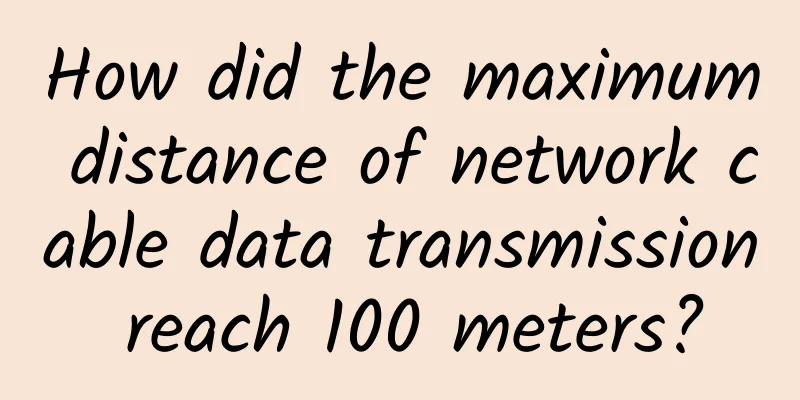Wu Hequan: The proportion of IPv6 traffic in domestic applications still needs to be improved

|
At the "2020 China IPv6 Development Forum" held on August 28, Academician Wu Hequan of the Chinese Academy of Engineering shared his analysis and thoughts on the large-scale deployment of IPv6.
Accelerate the large-scale deployment of IPv6 As we all know, the "6" in IPv6 refers to the sixth version of the TCP/IP protocol, which is designed mainly to solve the problem of IPv4 address shortage. By providing a large number of IP addresses, IPv6 can realize the interconnection of all things. Academician Wu Hequan said that IPv6 is one of the key technologies required for the construction of my country's new infrastructure. The scale deployment of its construction this year is divided into the following four aspects.
In addition, in the process of promoting IPv6, the Expert Committee focused on the technical requirements of the entire process of large-scale deployment, provided top-level design and hierarchical and classified guidance, and supported the planning of relevant departments. For example, the Cyberspace Administration of China issued the "Work Arrangements for Promoting Large-Scale Deployment of IPv6 in 2020", the Ministry of Industry and Information Technology issued the "Special Action to Improve IPv6 End-to-End Connectivity Capabilities in 2020", and the State Administration of Radio and Television issued the "Deployment and Promotion of IPv6 Transformation for Internet and Telecommunications Services in 2020". "A large number of addresses alone is not enough to promote the development of IPv6. We should tap into more potential of IPv6," said Academician Wu Hequan. At the end of 2019, under the guidance of the Expert Committee for Promoting Large-Scale Deployment of IPv6, the "IPv6+ Technology Innovation Working Group" was established. Academician Wu Hequan introduced the key tasks of the working group: First, focusing on typical application scenarios and services of 5G and cloud, research on IPv6+ network requirements, the synergy between terminals, networks and clouds, new protocol standards, etc.; second, through application pilot research, IPv6-oriented bearer technologies and networking solutions, including network programming, smooth evolution, large-scale networking, rapid service provisioning, reliability protection, etc., promote the formulation of international and domestic application standards for IPv6+ to provide guidance and suggestions for the deployment of existing networks; third, based on the IPv6 test environment, select typical technologies and networking solutions, focus on key business needs, bearer networking functionality and management and control capabilities, carry out testing and verification, and further discuss the synergy between terminals, networks and clouds. The proportion of IPv6 traffic in domestic applications still needs to be improved Academician Wu Hequan pointed out that the large-scale deployment of IPv6 in my country is showing an accelerating development trend, but there are also some problems that need to be further resolved. The data shows that in terms of active IPv6 users, based on real-time sampling and detection of 30 typical Internet applications, as of July 2020, the number of active IPv6 users in my country has reached 362 million, accounting for about 40.01% of Chinese netizens; in terms of IPv6 traffic, in the metropolitan area network, the IPv6 two-way traffic is 6968.412 Gbps, and the IPv6/IPv4 traffic accounts for 2.03%; in the LTE core network, the IPv6 two-way traffic is 4372.06 Gbps, and the IPv6/IPv4 traffic accounts for 9.77%. From the perspective of IPv6 support for application technology facilities, the IPv6 transformation of data centers (IDCs) has been steadily advancing, and the super-large, large, and small and medium-sized IDCs of the three major basic telecommunications companies have basically completed the IPv6 transformation. As of July 2020, all 907 IDC IPv6 transformations have been completed, and 863 IDCs have been connected to the National IPv6 Development Monitoring Platform. The content distribution network (CDN) has initially acquired the ability to provide services nationwide. 12 typical CDN companies support IPv6 capabilities nationwide, and the number of CDN nodes that have completed IPv6 transformation is 3,701, accounting for 75.63%. In terms of cloud service platforms, as of July 2020, the average IPv6 support rate of 11 public cloud platforms was 80.81%, and the transformation progress was lagging behind. In addition, 20 key cloud services, cloud hosts, domain name resolution, and object storage IPv6 availability are good, and IPv6 service types need to be increased. From the perspective of IPv6 support for mobile terminals and fixed terminals, mobile terminals have good support for IPv6. The top 10 brands of mobile terminals in the domestic market all support IPv6, and mobile phones and home gateway terminals purchased by basic telecommunications companies all support IPv6. However, home wireless routers have become a bottleneck in the development of IPv6. Comparing the first and second batches of home wireless router samples sent for inspection, in the first batch, 6 out of 13 samples supported IPv6, and only 2 out of 9 self-purchased samples supported it. In the second batch, all samples sent for inspection supported it. However, there is still a problem, that is, the newly launched routers support IPv6, which is limited to more well-known manufacturers, while non-mainstream manufacturers and those that have not been tested still account for a certain proportion in the market. Therefore, Academician Wu Hequan suggested that relevant government departments can include home wireless routers in the scope of network access testing. From the perspective of network and application IPv6 support, government and central enterprise websites took the lead, and the IPv6 support rate of news websites increased significantly. Among the 91 provincial and ministerial government portals, 88 support IPv6 access, accounting for 96.70%; 81 of the 96 central enterprise portals support IPv6 access, accounting for 84.38%; 6 of the 13 important central news websites support IPv6 access, accounting for 46.15%; 73 of the 137 "double first-class" university websites support IPv6 access, accounting for 53.30%. Typical commercial websites actively promote IPv6 upgrades and guide user conversions in an orderly manner. As of July 2020, the TOP100 commercial websites and applications fully support IPv6 access. However, when comparing IPv6 traffic of domestic and foreign applications, the average IPv6 traffic ratio of 7 applications was tested in a Wi-Fi test environment by foreign APPs, and the average IPv6 traffic ratio was 89.71%; the average IPv6 traffic ratio of 100 applications was tested in a 30-province LTE network environment of the three major operators by domestic APPs, and the test results showed that the average IPv6 traffic ratio was 32.52%. It can be seen that the proportion of IPv6 traffic of domestic applications still needs to be improved. IPv6+ stimulates network service innovation In order to meet the needs of ubiquitous intelligent interconnection in the future, the industry has creatively proposed "IPv6+" based on IPv6. "IPv6+" is represented by technologies such as SRv6, network slicing, flow detection, new multicast and application-aware networks, combined with intelligent "network autonomous driving" innovative technologies. It can meet the needs of multi-cloud one network, intelligent connection, intelligent operation, and intelligent operation and maintenance brought about by the interconnection of all things and the cloudization of thousands of industries, and realize true network following the cloud and intelligent connection of all things. Academician Wu Hequan pointed out that the development of the IPv6+ innovation system can be divided into three stages.
Academician Wu Hequan said, "We hope to stimulate network business innovation and improve network service quality through the development of IPv6's innovative capabilities. China is currently ahead of the curve in this regard. In relevant international standardization organizations, domestic companies and research institutions are actively promoting the standardization of some IPv6+ new capabilities. We hope that through these standardization efforts, the entire IPv6 network will not only solve the IP address problem, but also meet the rigid needs of new services in the new era, bringing value to network operators, content providers, and end users." |
<<: What secrets do you not know about the spanning tree protocol?
>>: How to break through the bottleneck of opening up my country's telecommunications sector?
Recommend
Which of the three major operators has the first chance in 5G research and development? How will life be disrupted?
[[177286]] It is reported that my country will la...
Solutions for 5G Network Security Threats
With the support of artificial intelligence techn...
Fiber Optic Innovation: Exploring Cutting-Edge Research and Development
Fiber optic technology has revolutionized innovat...
In the DT era, what is the trend of data center cabling?
As enterprises realize that structured cabling is...
Three lives and all things go hand in hand with wisdom | Beijing Unicom and Huawei jointly release the results of 5G Capital innovation project
[Shanghai, China, November 12, 2020] During the 2...
What Every Developer Should Know About TCP
Why do you need to place servers geographically c...
IoT and 5G are changing the world
By 2025, there will be 5 billion cellular-connect...
Looking forward to the love and hate of IPv6 deployment in the new Internet era
With the explosive development of the Internet, t...
Optical network campus under the background of new education infrastructure: the construction of Ethernet all-optical network of Anhui Sino-Australian Vocational College of Science and Technology
Anhui Sino-Australian Vocational College of Scien...
Do you understand the benefits of 5G? Learn about the pros and cons
We talk about 5G every day, but do you know what ...
5G development has achieved remarkable results, and the number of terminal connections has exceeded 100 million
On the afternoon of September 22, the State Counc...
InspireVM: $2/month KVM-512MB/7G NVme/512GB/Chicago Data Center
InspireVM is a site under Inspire Solutions LLC. ...
The three major operators have been delisted. Do those outstanding shares have to be repurchased?
The hottest news during the New Year's Day wa...
Why is the latency so high for a simple HTTP call? Let’s capture a packet and analyze it
1. Recently, a strange phenomenon occurred in the...
VirMach: $7.5/year KVM-384MB/10GB/500GB/multiple data centers
The tribe has not shared information about VirMac...









